Wearing goggles under a helmet is essential for ensuring both safety and comfort during outdoor activities, such as skiing, snowboarding, biking, or motocross. Properly fitting goggles not only protect your eyes from wind, snow, dust, and debris but also enhance visibility in various weather conditions.
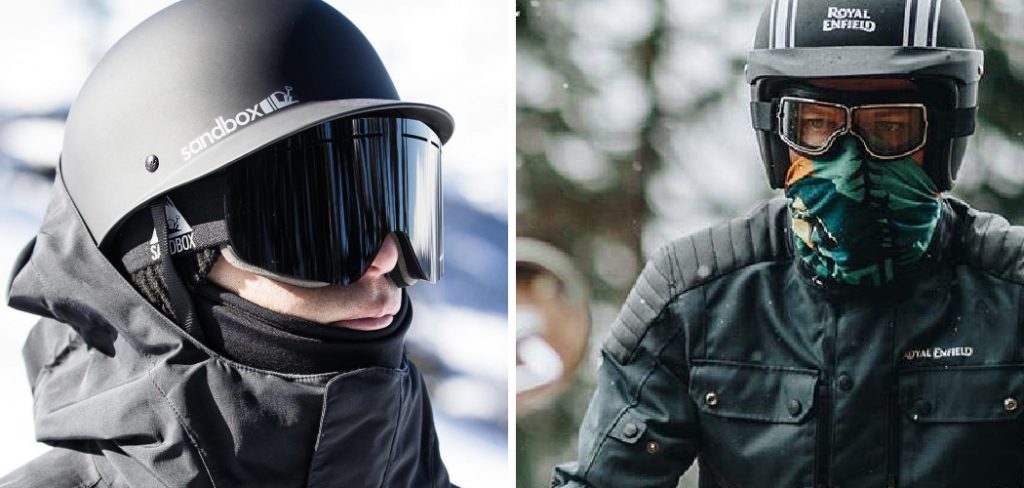
This guide on how to wear goggles under helmet will provide you with step-by-step instructions and practical tips for achieving a secure and comfortable fit, maximizing your performance and enjoyment while keeping your eyes well-protected.
Why Wear Goggles Under Helmet
Wearing goggles under a helmet offers several benefits, making it an important aspect of your outdoor gear.
Protection:
Goggles provide a physical barrier between your eyes and the elements, including wind, snow, rain, sun glare, and debris. This is especially crucial for high-speed activities such as skiing or biking, where particles can cause serious eye injuries.
Enhanced Visibility:
Goggles come with different lens tints and coatings that enhance visibility in various weather conditions. For example, yellow or orange lenses can improve contrast and depth perception on cloudy days, while polarized lenses reduce glare from the sun.
Comfort:
Wearing goggles under a helmet also provides added comfort by keeping your eyes shielded from wind and cold temperatures. This is especially important for activities like skiing or snowboarding where prolonged exposure to strong winds can cause discomfort and even frostbite.
Helmet Compatibility:
Many helmets are designed with goggle straps to hold the goggles securely in place. Wearing goggles under a helmet ensures that they fit properly without interfering with the helmet’s fit or compromising its safety features.
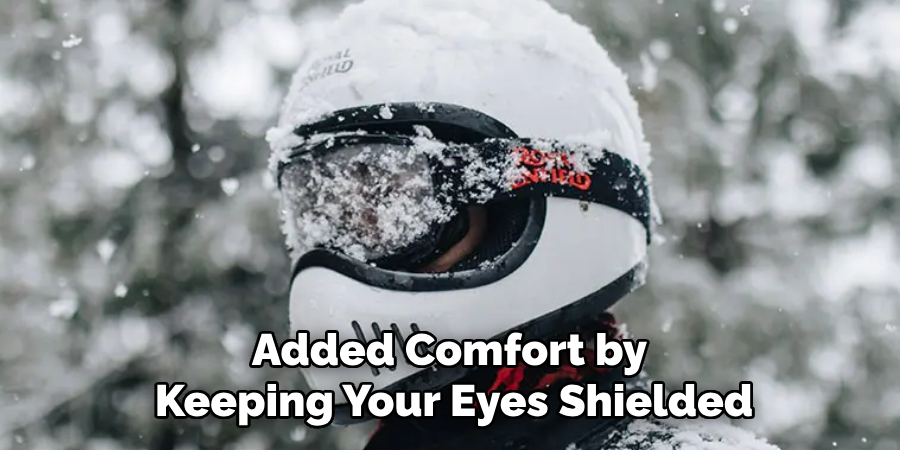
6 Steps on How to Wear Goggles Under Helmet
Step 1: Choose the Right Goggles
Selecting the right pair of goggles is the first and most crucial step to ensure both protection and comfort. When choosing goggles, consider the following factors:
Fit and Size:
Make sure the goggles fit snugly on your face without pressing too tightly. The foam padding should be comfortable against your skin, and the goggles should cover your eyes completely.
Lens Type and Tint:
Choose lenses based on the predominant weather conditions you’ll be facing. For example, yellow or orange lenses enhance contrast on cloudy days, while polarized lenses reduce glare on sunny days. Some lenses also come with anti-fog coatings, which are beneficial in preventing fogging during strenuous activities.
Ventilation:
Good ventilation is crucial to prevent fogging and maintain clear visibility. Look for goggles with multiple vents that allow air to circulate.
Helmet Compatibility:
Ensure that the goggles are compatible with your helmet. They should fit well inside the helmet’s frame without causing discomfort or compromising the helmet’s safety.
Strap Adjustability:
The strap should be easily adjustable to ensure a secure fit. Some goggles come with silicone-lined straps to prevent slipping.
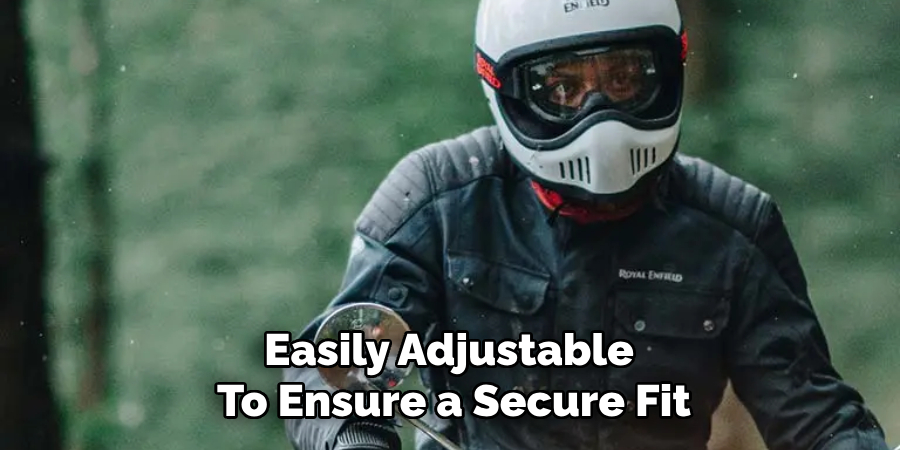
By paying attention to these factors, you’ll be better equipped to find goggles that meet your specific needs, offering optimal protection and comfort during your outdoor adventures.
Step 2: Put on the Helmet
After selecting the right pair of goggles, the next step is to put on your helmet properly. Here’s how to do it:
Adjust the Helmet Fit:
- Make sure the helmet fits snugly on your head without being too tight. You should be able to wear it for extended periods without discomfort.
- Use the adjustment mechanisms (such as straps or dials) to fine-tune the fit. The helmet should sit level on your head, covering your forehead without obstructing your vision.
Secure the Straps:
- Buckle the chin strap and tighten it so that it’s snug but not restrictive. You should be able to fit one or two fingers between the strap and your chin.
- Ensure that the side straps form a “Y” shape and sit just below your earlobes. Adjust them if necessary.
Check for Stability:
- Wiggle the helmet back and forth and side to side to make sure it remains stable and doesn’t shift excessively.
- Make any additional adjustments for a secure and comfortable fit.
After ensuring that your helmet is properly fitted and secure, you are now ready to move on to the next step, which involves putting on the goggles. Following these steps closely helps ensure your safety and comfort during your outdoor activities.
Step 3: Put on the Goggles
Now that your helmet is securely in place, it’s time to put on the goggles. Here’s how:
Adjust the Straps:
- Loosen the straps so that they are wide enough to fit comfortably around your head.
- Make sure the strap sliders are positioned at an equal distance from each side of the goggles.
- Hold the goggle frame against your face and tighten the straps gradually until they fit snugly and comfortably.
Position the Goggles:
- Place the goggles over your eyes, making sure that they cover them completely and the foam padding seals around them.
- Adjust the goggles so that they sit comfortably on your nose and cheeks without causing pressure.
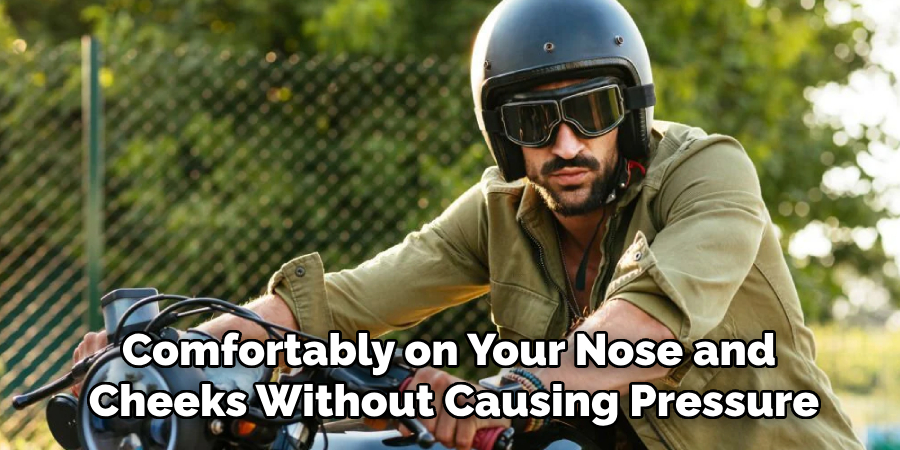
Secure the Goggles:
- Fasten the strap at the back of your helmet, making sure it’s not too tight or too loose. The goggles should feel secure but not overly constricting.
Congratulations! You have successfully put on your goggles under your helmet. However, it’s important to make some final adjustments to ensure a comfortable fit and optimal performance.
Step 4: Make Final Adjustments
Before heading out on your adventure, take a few minutes to make any final adjustments to your goggles and helmet for maximum comfort. Here are some tips:
- Ensure the foam padding around the goggles sits comfortably against your face without any gaps.
- Check that the goggles are not too tight or loose around your temples and nose. If necessary, adjust the straps accordingly.
- If you’re wearing prescription glasses underneath your goggles, make sure they fit comfortably inside the goggle frame without causing discomfort or distortion.
Step 5: Test Your Visibility
Once your goggles and helmet are securely in place and adjusted for comfort, the next crucial step is to test your visibility. Ensuring clear vision is essential for your safety and performance during your outdoor activities. Follow these guidelines to test your visibility effectively:
Check for Obstructions:
- Look in multiple directions—up, down, left, and right—to ensure that there are no obstructions in your field of view. The goggles should provide a wide, unobstructed peripheral vision.
- Make sure the edge of the helmet or the straps do not interfere with your line of sight.
Inspect for Fogging:
- On the spot, test for any fogging issues by breathing normally for a minute. The anti-fog coating and ventilation system in the goggles should prevent any condensation buildup.
- If you experience fogging, consider loosening the strap slightly or adjusting the ventilation.
Verify Clarity:
- Check the clarity of the goggle lenses. There should be no distortions, scratches, or smudges that could impair your vision.
- If you are using tinted or polarized lenses, ensure that they provide the intended visual enhancement for the current weather conditions.
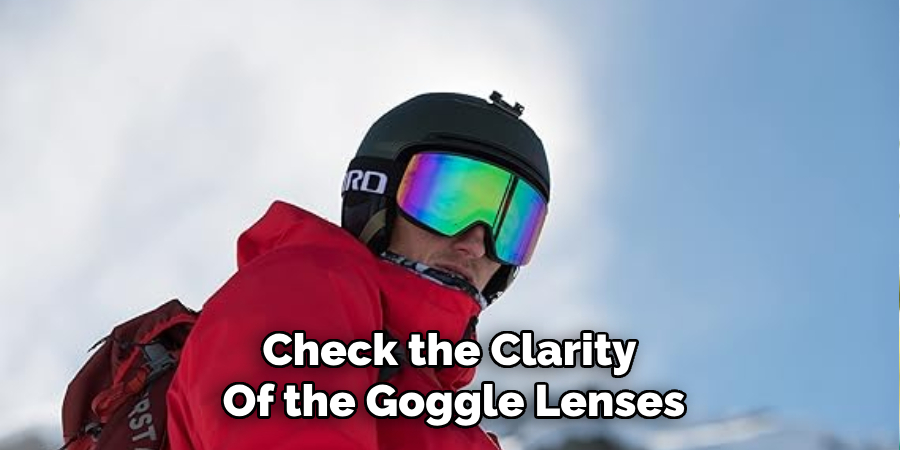
Ensure Prescription Glasses Fit (if applicable):
- If you wear prescription glasses under your goggles, confirm that they fit comfortably and do not cause any pressure points or visual distortion.
Simulate Movements:
- Mimic the movements you will be performing during your activity, such as turning your head quickly or looking down at your feet, to ensure that the goggles remain stable and your vision remains clear.
Testing your visibility thoroughly ensures that you can enjoy your outdoor adventure safely and without visual discomfort. With clear vision and secure protection, you are now ready to proceed confidently to the next step of your activity.
Step 6: Enjoy Your Adventure!
Now that you have successfully put on your helmet and goggles, made the necessary adjustments, and tested for visibility, it’s time to enjoy your outdoor adventure! Whether you’re skiing down a snowy mountain or biking through scenic trails, you can now focus on having fun while staying safe and comfortable. Remember to always check and adjust your helmet and goggles periodically throughout your activity for optimal performance.
With these tips on how to wear goggles under helmet in mind, you’ll be well-equipped to put on your goggles under your helmet like a pro every time. Have a great adventure!
Frequently Asked Questions
Q: Can I Wear Goggles Over My Helmet?
A: It is not recommended to wear goggles over your helmet as it can cause discomfort, reduce visibility, and compromise the helmet’s fit and function. It is best to wear goggles under your helmet for optimal performance and safety.
Q: Do I Need a Helmet When Wearing Goggles?
A: Yes, it is highly recommended to wear a helmet when wearing goggles during outdoor activities. Helmets provide crucial protection for your head and brain in case of accidents or falls, and they also help keep the goggles securely in place.
Q: Can I Wear Goggles Without a Helmet?
A: While you can technically wear goggles without a helmet, it is not recommended as it increases the risk of injury and reduces visibility. It also compromises the fit and stability of the goggles, making them less effective in protecting your eyes. Wearing both a helmet and goggles together provides optimal safety and performance during outdoor activities. Overall, it is best to always wear a helmet when participating in high-risk sports or activities and to wear goggles under your helmet for maximum protection and comfort.
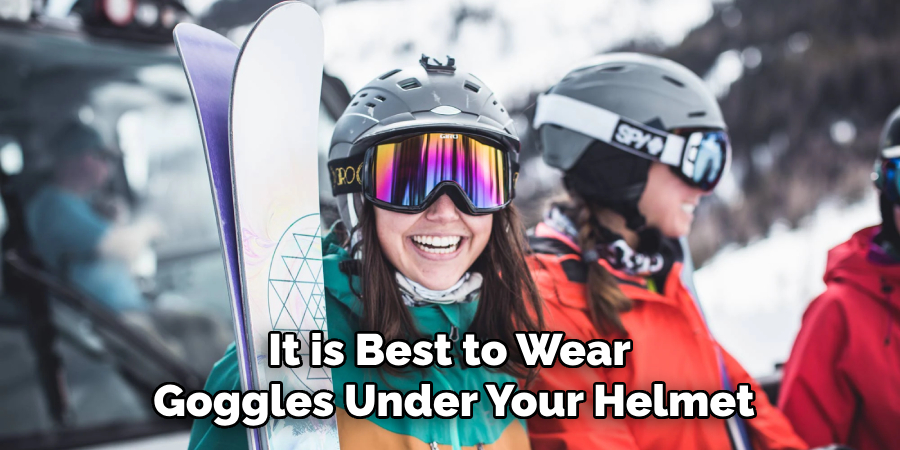
Q: How Often Should I Replace My Goggles?
A: It is recommended to replace your goggles every 1-2 years, or sooner if they show signs of wear and tear. This is especially important if the lenses are scratched or damaged, as it can compromise their effectiveness in protecting your eyes. Also, keep in mind that different weather conditions may require different types of goggles (i.e., tinted or polarized lenses), so consider replacing them accordingly for optimal visibility.
Conclusion
Wearing goggles under your helmet is an essential practice for ensuring safety, comfort, and optimal performance during your outdoor adventures. By following the steps outlined in this guide on how to wear goggles under helmet, you can achieve a secure and comfortable fit for both your goggles and helmet, allowing you to focus on enjoying your activity without the distraction of poorly adjusted gear.
Remember to regularly check and adjust your equipment, consider the specific weather conditions, and replace worn-out goggles as needed. With the right preparation and gear, you’re set to tackle any challenge that comes your way while staying protected and maintaining a clear vision. Happy adventuring!
About
Safety Fic is a distinguished figure in the world of Diy design, with a decade of expertise creating innovative and sustainable Diy solutions. His professional focus lies in merging traditional craftsmanship with modern manufacturing techniques, fostering designs that are both practical and environmentally conscious. As the author of diy, Safety Fic delves into the art and science of Safety Fic-making, inspiring artisans and industry professionals alike.
Education RMIT University
(Melbourne, Australia) Associate Degree in Design (Safety Fic) Focus on sustainable design, industry-driven projects, and practical craftsmanship. Gained hands-on experience with traditional and digital manufacturing tools, such as CAD and CNC software.
Nottingham Trent University
(United Kingdom) Bachelor’s in diyfastly.com and Product Design (Honors) Specialized in product design with a focus on blending creativity with production techniques. Participated in industry projects, working with companies like John Lewis and Vitsoe to gain real-world insights.
Publications and Impact
In diy, Safety Fic his insights on indoor design processes, materials, and strategies for efficient production. His writing bridges the gap between artisan knowledge and modern industry needs, making it a must-read for both budding designers and seasoned professionals.
